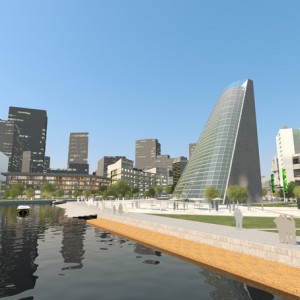
This is the type of Plantagon Greenhouse Building planned for Linköping. The slanted facade is adapted to temperate climate zones and sun conditions.
At this moment our fridge, fruit bowl and vegetable basket contains the produce of many nations. Plenty of healthy eating grown (mainly) under plastic in southern Spain and shipped to the UK in lorries. Other produce comes from even further afield, some of it even by air.
What if much of that food could be grown very much closer to home. I don’t mean in the fields around our towns and cities, where there isn’t the space, and where there is not enough water and the climate is wrong anyway. No, what if a sustantial amount of the vegetables, and some of the fruit, we need, could be grown in high-rise greenhouses in our towns and cities?
Fanciful and futuristic, you may say say. Futuristic, yes, if that’s how you want to define a building in a Swedish city likely to be finished within 18 months. Fanciful? That remains to be tested, although there is some interesting academic work which suggests that growing crops in a controlled environment in tall urban buildings could well work.
Swedish company Plantagon was founded in 2008, and already has its first test project on the ground, designed by architects Sweco, and by now possibly rising up from it as well. It is building its first “greenhouse for vertical farming” in the southern Swedish city of Linkoping, (102,000 population). It has backing from the Swedish government, and is working in conjunction with energy utility Tekniska Verken, which has a biogas plant next door.
This is believed to be the first high-rise greenhouse of its type in the world, designed to cut costs and environmental damage by eliminating transportation and delivering directly to consumers in city areas.
Plants will be grown in pots, and put on trays equipped with a nutrient solution reservoir as feed; they will be irrigated three times per day using an “ebb-and-flow” technique as they’re being moved around on conveyor belts, bathed in natural light, and sunlight, as they go.
At the end of the growing cycle the plants will be conveyed down to the ground floor to be automatically harvested, then dispatched. The pots will be cleaned and reused and the cycle will begin all over again.
It is understood Plantagon could be using plant residues and local manure in an anaerobic digester to generate biogas, to run boilers and chillers for heating and dehumidification. The plant is being built next to a biogas generating plant to use its excess heat.
So will this work? The idea has been around for some years. Microbiologist and ecologist Dickson Despommier has suggested that a 30-story building could feed 50,000 people a year.
But commentators who have expertise in this field and have looked closely, such as the Treehugger website, have been sceptical. Until recently, that is.
Lloyd Alter of Treehugger warmed to the idea when he was an external examiner to graduate student Gordon Graff when Graff defended his MSc thesis “Skyfarming”.
Alter wrote: “Gordon Graff’s thesis is not fully resolved [but] so far as I can tell (and I have looked at a lot of vertical farm proposals) it is the first time that anyone has made a plausible case for why one would want to put a vertical farm in the middle of a city, and shown how it might really work technically and economically. The vertical farm is no longer just pie in the sky.“
Cities are likely to need some radically new ways of feeding themselves, before long. Graff wrote: “Vertical farming would increase a city’s resilience to the more long- term, systemic alterations that human society is widely expected to experience in the coming decades. With vertical farming’s maximally efficient resource use and functional segregation from the natural world, cities could achieve food security amidst the environmental transformations and resource shortages that would cripple a conventional urban food network.”
Science-fiction films are full of examples of this sort of thing, but rather light on the technical detail of how to create them in the real world. It’s not difficult to imagine great high-rise greenhouses 50 years from now, using techniques and technology we hardly know about, doing the job. If Plantagon’s project works, the greenhouse skyscraper could be much closer than we think.
The last word comes from Treehugger’s Alter:
“In California, an acre of lettuce sucks up 1800 – 3500 cubic meters of water; Graff’s Skyfarm consumes 14.4 cubic meters, 1/240th as much. That is a very compelling reason to sit up and notice vertical farming.”
